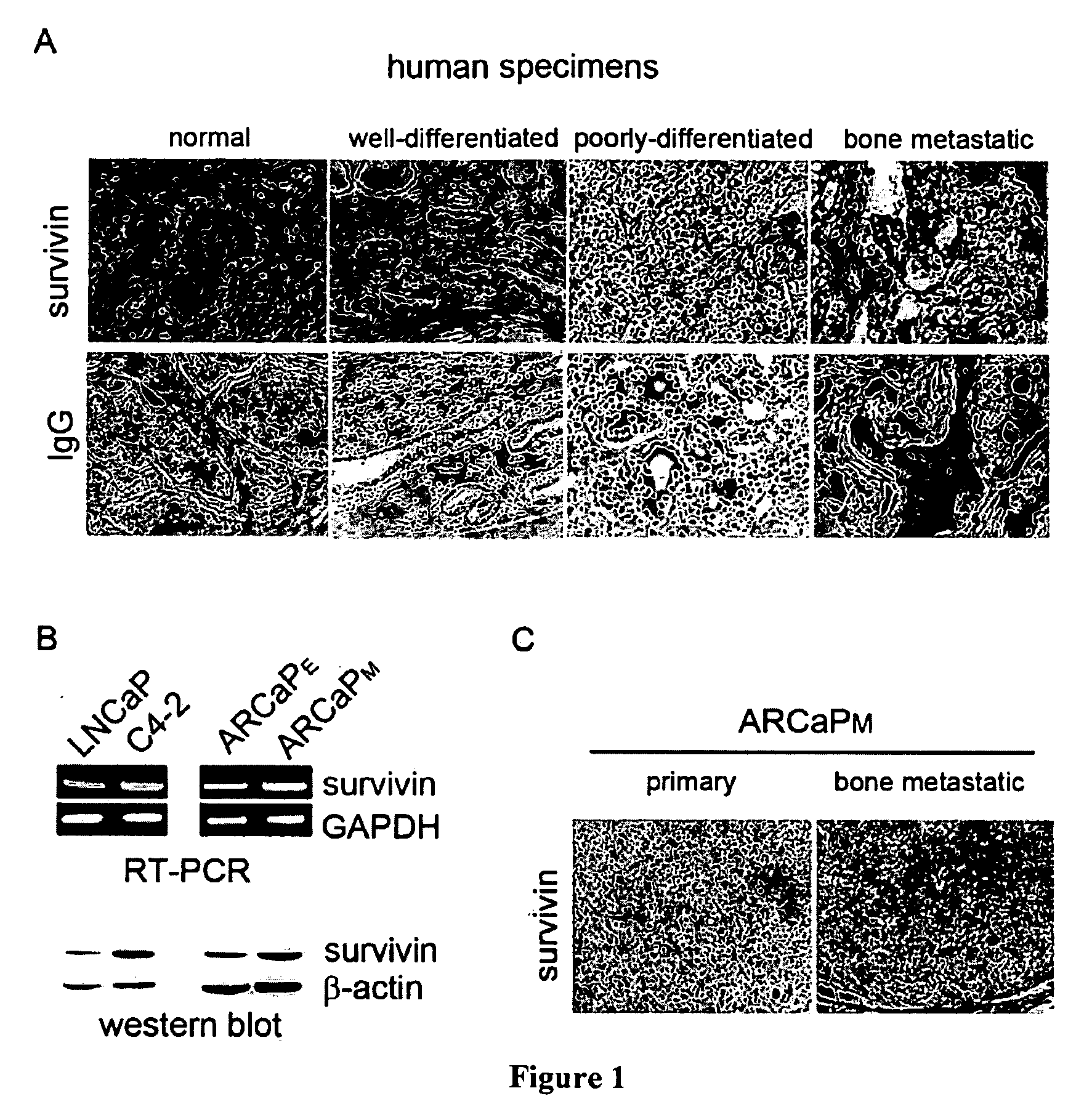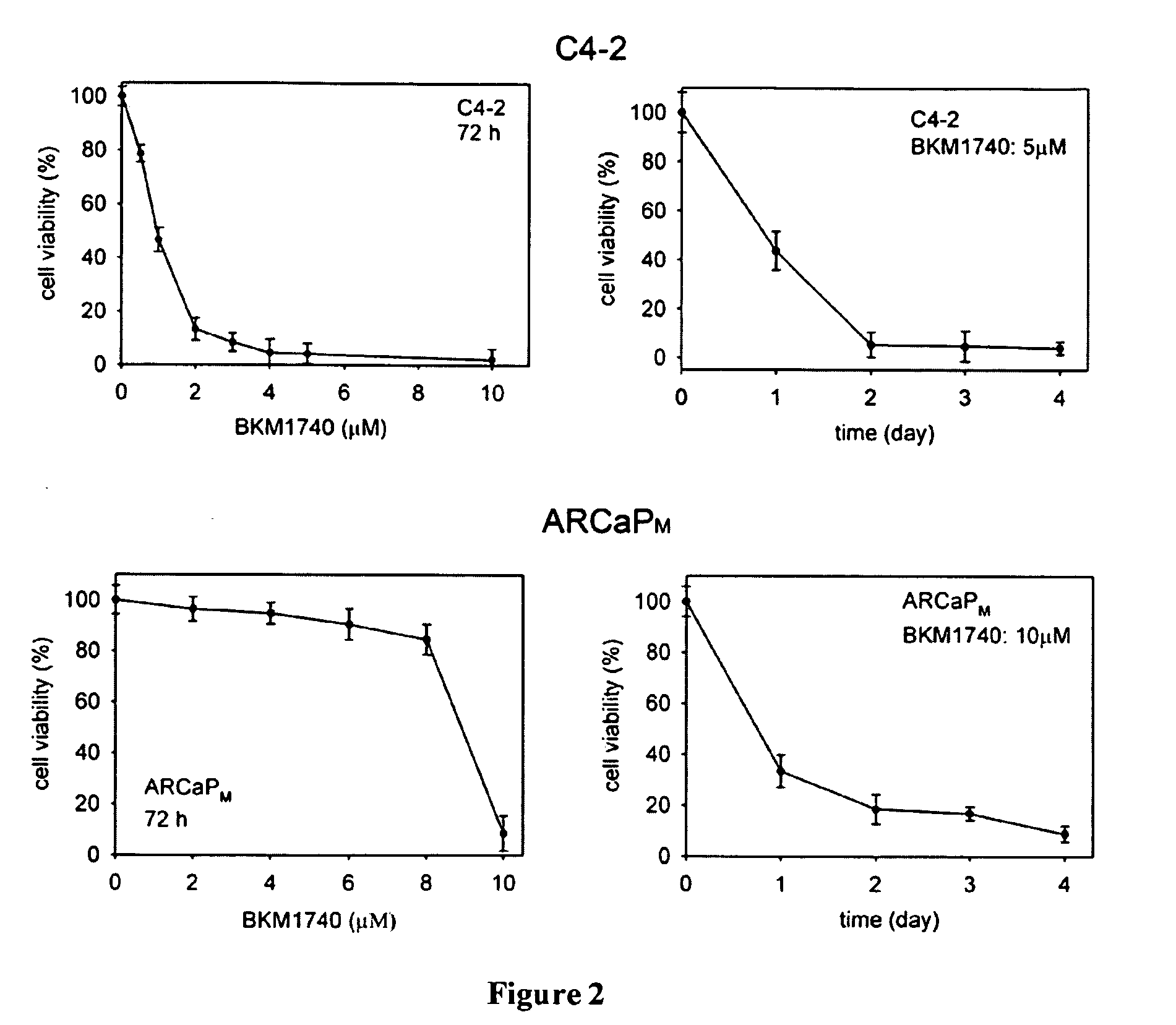Compositions and methods for treating bone cancer
a bone cancer and composition technology, applied in the field of bone cancer compositions and methods, can solve the problems of inability to meet the bone metastases of androgen-resistant prostate cancer patients, inability to achieve satisfactory treatment options, and large side effects of therapies, etc., to achieve high affinity, effective localization of anticancer compounds, and high affinity to bone
- Summary
- Abstract
- Description
- Claims
- Application Information
AI Technical Summary
Benefits of technology
Problems solved by technology
Method used
Image
Examples
example 1
Synthesis of [[[N-(2,3,4,5,6-pentafluorocinnamoyl)-O-[(2,6-dichlorophenyl)methyl]-L-tyrosyl]amino]methylene]bis(phosphonic acid) tetraethyl ester (BKM-1644, F5c-OC2Y-[AMDP(OEt)4], C34H37Cl2F5N2O9P2: 845.52)
[0093]To a solution of N-tent-butoxycarbonyl-O-(2,6-dichlorobenzyl)-L-tyrosine (Boc-OC2Y, 440.32 mg, 1.0 mmol), tetraethyl aminomethylenediphosphonate (AMDP(OEt)4, 303.23 mg=255.03 μl, 1.0 mmol), and BOP (442.3 mg, 1.0 mmol) in acetonitrile (75 ml) was added N,N-diisopropylethylamine (360 μl, 2.0 mmol). The mixture was stirred at room temperature overnight then the solvent was removed in vacuum. The residue was partitioned between ethyl acetate (75 ml) and water (15 ml). The layers were separated and the organic phase was washed with 5% KHSO4 (3×15 ml), brine (15 ml), 5% NaHCO3 (3×15 ml), brine (15 ml). The organic layer was dried over anhydrous Na2SO4. The solvent was evaporated, affording a semi-solid product, (682 mg, 94.0%), [[[N-[(1,1-dimethylethoxy)carbonyl]-O-[(2,6-dichloro...
example 2
Synthesis of 1-{[N-(2,3,4,5,6-pentafluorocinnamoyl)-O-(2,6-dichlorobenzyl)]L-tyrosyl}-4-[bis(diethoxyphosphono)]methylaminopiperidine (BKM-1740, F5c-OC2Y-Pipe[AMDP(OEt)4], C39H46Cl2F5N3O9P2: 928.65)
[0098]To a solution of N-tent-butoxycarbonyl-O-(2,6-dichlorobenzyl)-L-tyrosine (Boc-OC2Y, 880.64 mg, 2.0 mmol), 4-piperidone monohydrate hydrochloride (307.2 mg, 2.0 mmol) and BOP (884.6 mg, 2.0 mmol) in acetonitrile (75 ml) was added N,N-diisopropylethylamine (1.05 ml, 6.0 mmol). The mixture was stirred at room temperature overnight then the solvent was removed in vacuum. The residue was partitioned between ethyl acetate (75 ml) and water (25 ml). The layers were separated and the organic phase was washed with 5% KHSO4 (3×25 ml), brine (25 ml), 5% NaHCO3 (3×25 ml), brine (25 ml). The organic layer was dried over anhydrous Na2SO4. The crude, semi-solid product (Boc-OC2Y-Pipo, C26H30Cl2N2O5: 521.44, 1030 mg, 98.8%) obtained after evaporation of the solvent in vacuum (t<40° C.), was submitt...
example 3
[0103]The studies described in this Example were designed to (a) determine the in vivo efficacy of BKM1740, a small-molecule, acyltyrosine bisphosphonate amide derivative, against human prostate cancer cell growth and survival in bone, and (b) investigate the molecular mechanism by which BKM1740 augments apoptosis in bone metastatic prostate cancer cells.
A. Survivin Expression Correlates with Bone Metastasis in Human Prostate Cancer Tumors.
[0104]To investigate the clinicopathologic significance of survivin expression in human prostate cancer progression, immunohistochemistry protein expression of survivin was analyzed in primary and bone metastatic prostate cancer tissue. Well-differentiated prostate cancer was defined as Gleason score ˜6 and poorly-differentiated prostate cancer as Gleason score ˜8. In all specimens, survivin expression was undetectable or very low in normal / benign glands, but was increased in well-differentiated cancer to poorly-differentiated cancers. Importantly...
PUM
| Property | Measurement | Unit |
|---|---|---|
| chemical structure | aaaaa | aaaaa |
| structure | aaaaa | aaaaa |
| chemical properties | aaaaa | aaaaa |
Abstract
Description
Claims
Application Information
 Login to View More
Login to View More - R&D
- Intellectual Property
- Life Sciences
- Materials
- Tech Scout
- Unparalleled Data Quality
- Higher Quality Content
- 60% Fewer Hallucinations
Browse by: Latest US Patents, China's latest patents, Technical Efficacy Thesaurus, Application Domain, Technology Topic, Popular Technical Reports.
© 2025 PatSnap. All rights reserved.Legal|Privacy policy|Modern Slavery Act Transparency Statement|Sitemap|About US| Contact US: help@patsnap.com



